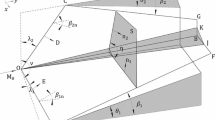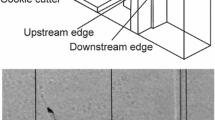Abstract
The present study focuses on the long-term behavior of low-enthalpy M = 7 flows over double wedges that have a fixed fore angle of 30° and aft angles ranging from 45° to 60°. Although there are numerical and experimental studies available in the literature, they mostly consider the short-term behavior of such flows. In one of those studies, Durna et al. (Phys. Fluids 28:096101, 2016) foresee the presence of an aft angle threshold for transition from steady flow to complex shock–boundary layer interactions. The present study investigates the presence of periodicity by performing computations up to 50 times the duration of the previous study. Our analyses show that beyond a threshold value of 47°, the flows become time-periodic. We are able to describe complex interaction mechanisms of the periodic flow by utilizing the density gradients, shock locations, separation angle, and distributions of the pressure and heat flux over the wedge surfaces. The computational results show that as the aft angle is increased, the period of the flow shortens, and the duration, when the transmitted shock impinges on the wedge surface, decreases.




























Similar content being viewed by others
References
Edney, B.: Anomalous Heat Transfer and Pressure Distributions on Blunt Bodies at Hypersonic Speeds in the Presence of an Impinging Shock. Flygtekniska försöksanstalten, Stockholm (1968)
Babinsky, H., Harvey, J.: Shock Wave–Boundary-Layer Interactions. Cambridge University Press, Cambridge (2011). https://doi.org/10.1017/cbo9780511842757
Hu, Z., Myong, R., Cho, T.: Numerical study of shock interactions in viscous, hypersonic flows over double-wedge geometries. In: Hannemann, K., Seiler, F. (eds.) Shock Waves, pp. 671–676. Springer, Berlin (2009). https://doi.org/10.1007/978-3-540-85168-4_108
Hu, Z.M., Myong, R.S., Yang, Y.R., Cho, T.H.: Reconsideration of inviscid shock interactions and transition phenomena on double-wedge geometries in a M ∞ = 9 hypersonic flow. Theor. Comput. Fluid Dyn. 24, 551–564 (2010). https://doi.org/10.1007/s00162-010-0188-4
Qinghu, Z., Shihe, Y., Zhi, C., Yangzhu, Z., Yongwei, Z.: Visualization of supersonic flow over double wedge. J. Vis. 16, 209–217 (2013). https://doi.org/10.1007/s12650-013-0172-3
Olejniczak, J., Wright, M.J., Candler, G.V.: Numerical study of inviscid shock interactions on double-wedge geometries. J. Fluid Mech. 352, 1–25 (1997). https://doi.org/10.1017/S0022112097007131
Ben-Dor, G., Vasilev, E.I., Elperin, T., Zenovich, A.V.: Self-induced oscillations in the shock wave flow pattern formed in a stationary supersonic flow over a double wedge. Phys. Fluids 15, L85–L88 (2003). https://doi.org/10.1063/1.1625646
Hu, Z.M., Myong, R.S., Wang, C., Cho, T.H., Jiang, Z.L.: Numerical study of the oscillations induced by shock/shock interaction in hypersonic double-wedge flows. Shock Waves 18, 41–51 (2008). https://doi.org/10.1007/s00193-008-0138-x
Mortazavi, M., Knight, D.D.: Shock wave laminar boundary layer interaction at a hypersonic flow over a blunt fin-plate junction. 55th AIAA Aerospace Sciences Meeting, Grapevine, TX, AIAA Paper 2017-0536 (2017). https://doi.org/10.2514/6.2017-0536
Knisely, A.M., Austin, J.M.: Geometry and test-time effects on hypervelocity shock–boundary layer interaction. 54th AIAA Aerospace Sciences Meeting, San Diego, CA, AIAA Paper 2016-1979 (2016). https://doi.org/10.2514/6.2016-1979
Knight, D., Chazot, O., Austin, J., Badr, M.A., Candler, G., Celik, B., de Rosa, D., Donelli, R., Komives, J., Lani, A., Levin, D., Nompelis, I., Panesi, M., Pezzella, G., Reimann, B., Tumuklu, O., Yuceil, K.: Assessment of predictive capabilities for aerodynamic heating in hypersonic flow. Prog. Aerosp. Sci. 90, 39–53 (2017). https://doi.org/10.1016/j.paerosci.2017.02.001
Durna, A.S., El Hajj Ali Barada, M., Celik, B.: Shock interaction mechanisms on a double wedge at Mach 7. Phys. Fluids 28, 096101 (2016). https://doi.org/10.1063/1.4961571
Swantek, A.B., Austin, J.M.: Flowfield establishment in hypervelocity shock-wave/boundary-layer interactions. AIAA J. 53, 311–320 (2015). https://doi.org/10.2514/1.j053104
Badr, M.A., Knight, D.D.: Shock wave laminar boundary layer interaction over a double wedge in a high mach number flow. 52nd Aerospace Sciences Meeting, National Harbor, MD, AIAA Paper 2014-1136 (2014). https://doi.org/10.2514/6.2014-1136
Komives, J.R., Nompelis, I., Candler, G.V.: Numerical investigation of unsteady heat transfer on a double wedge geometry in hypervelocity flows. 44th AIAA Fluid Dynamics Conference, Atlanta, GA, AIAA Paper 2014-2354 (2014). https://doi.org/10.2514/6.2014-2354
Swantek, A.B., Austin, J.M.: Heat transfer on a double wedge geometry in hypervelocity air and nitrogen flows. 50th AIAA Aerospace Sciences Meeting including the New Horizons Forum and Aerospace Exposition, Nashville, TN, AIAA Paper 2012-284 (2012). https://doi.org/10.2514/6.2012-284
Swantek, A.: The role of aerothermochemistry in double cone and double wedge flows. PhD Thesis, University of Illinois (2012)
Hashimoto, T.: Experimental investigation of hypersonic flow induced separation over double wedges. J. Therm. Sci. 18, 220–225 (2009). https://doi.org/10.1007/s11630-009-0220-4
Reinert, J.D., Gs, S., Candler, G.V., Komives, J.R.: Three-dimensional simulations of hypersonic double wedge flow experiments. 47th AIAA Fluid Dynamics Conference, Denver, CO, AIAA Paper 2017-4125 (2017). https://doi.org/10.2514/6.2017-4125
Chase, M.W.: NIST-JANAF Thermochemical Tables (1998)
Greenshields, C.J., Weller, H.G., Gasparini, L., Reese, J.M.: Implementation of semi-discrete, non-staggered central schemes in a colocated, polyhedral, finite volume framework, for high-speed viscous flows. Int. J. Numer. Methods Fluids 63, 1–21 (2010). https://doi.org/10.1002/fld.2069
OpenCFD, O.: The Open Source CFD Toolbox. User Guide. OpenCFD Ltd, Sindelfingen (2009)
Marcantoni, L.F.G., Tamagno, J.P., Elaskar, S.A.: High speed flow simulation using OpenFOAM. Asoc. Argentina Mec. Comput. 31, 2939–2959 (2012)
Hinman, W.S., Johansen, C.T.: Rapid prediction of hypersonic blunt body flows for parametric design studies. Aerosp. Sci. Technol. 58, 48–59 (2016). https://doi.org/10.1016/j.ast.2016.08.007
Hinman, W.S., Johansen, C.T.: Mechanisms in the hypersonic laminar near wake of a blunt body. J. Fluid Mech. 839, 33–75 (2018). https://doi.org/10.1017/jfm.2017.902
Hinman, W.S., Johansen, C.T.: Interaction theory of hypersonic laminar near-wake flow behind an adiabatic circular cylinder. Shock Waves 26, 717–727 (2016). https://doi.org/10.1007/s00193-015-0615-y
Arisman, C.J., Johansen, C.T.: Nitric oxide chemistry effects in hypersonic boundary layers. AIAA J. 53, 3652–3660 (2015). https://doi.org/10.2514/1.J053979
Arisman, C.J., Johansen, C.T., Bathel, B.F., Danehy, P.M.: Investigation of gas seeding for planar laser-induced fluorescence in hypersonic boundary layers. AIAA J. 53, 3637–3651 (2015). https://doi.org/10.2514/1.J053892
Hunt, J.C.R., Wray, A.A., Moin, P.: Eddies, streams, and convergence zones in turbulent flows. Proceedings of the Summer Program, Center for Turbulence Research, pp. 193–208 (1988)
Dubief, Y., Delcayre, F.: On coherent-vortex identification in turbulence. J. Turbul. 1, N11 (2000). https://doi.org/10.1088/1468-5248/1/1/011
Acknowledgements
This study was funded by the projects of Istanbul Technical University (BAP, 39600) and TUBITAK (215M907). Computing resources used in this work were provided by the National Center of High Performance Computing of Turkey (UHEM) under Grant No. 5004292016.
Author information
Authors and Affiliations
Corresponding author
Additional information
Communicated by K. Kontis and A. Higgins.
Rights and permissions
About this article
Cite this article
Durna, A.S., Celik, B. Time-periodic shock interaction mechanisms over double wedges at Mach 7. Shock Waves 29, 381–399 (2019). https://doi.org/10.1007/s00193-018-0864-7
Received:
Revised:
Accepted:
Published:
Issue Date:
DOI: https://doi.org/10.1007/s00193-018-0864-7




